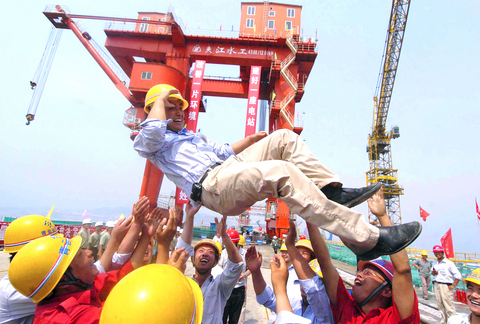After 13 years of immense physical effort and technical ingenuity, China yesterday put the finishing touches to its controversial Three Gorges dam, the world's largest hydropower project.
The official completion of the dam was marked by a short ceremony at the site broadcast live on state television, which touted it as an "important historic moment."
"I can announce to the Chinese people ... that the Three Gorges dam is completed," Li Yong'an, manager of the Three Gorges Construction Company, said shortly after the last load of cement was poured onto the top of the dam.

PHOTO: AP/XINHUA
The 2,309m-long, 185m-high block of concrete across the Yangtze is meant to control floods and generate electricity for a power-hungry nation, but for many Chinese it is about much more than that.
"The Three Gorges dam is excellent proof of what Chinese can accomplish," said Cao Guangjing, vice president of the China Yangtze Three Gorges Project Development Corporation. "This project will serve to inspire the Chinese people."
Although the final tonne of concrete has been poured, the immense structure will still not be fully operational for another two years.
The last generators need to be installed, and work still needs to be done on the ship lift that, together with a ship lock, will allow ocean-going vessels to navigate the vast reservoir that is filling up behind the dam.
Although it is not all over yet, many of the engineers felt it as if a page had been turned and a chapter in their personal lives was nearing conclusion.
"I started in 1993, fresh from university, and I have been here ever since," said engineer Wang Zilin, 43, from Zhejiang Province. "It's been my whole life. I even found my wife here."
Even while work was being carried out on the dam, engineers and laborers were reminded that flood control was one of the main reasons behind the giant project.
In 1998, a devastating flood on the Yangtze uprooted millions of families and killed more than 1,500 people. Two much larger disasters in the 1930s each claimed more than 140,000 lives.
Nevertheless, critics continue to argue that silt build-up and other problems mean the dam will fail to provide the hoped-for flood relief.
Opponents also see damage to the environment, ruin to China's heritage and misery to local residents forced from their homes for the project.
However, harnessing the power of China's mightiest rivers is a dream harbored by generations of Chinese.
In the early 20th century, Sun Yat-sen (
Mao Zedong (
It is no longer just the stuff of poetry. On the left bank, 14 sets of 700-megawatt turbine and generator units are already in operation.
On the right bank, another 12 700-megawatt units are under construction.
With a capacity already equivalent to Itaipu on the border of Brazil and Paraguay, which is now the world's largest operating hydroelectric dam, the Three Gorges will eventually overshadow all others.
A new tender process is due to be held by the end of the year for adding a new power station with another six 700-megawatt generators, underground on the right bank.
The dam will then become "the biggest in the world," according to the China Yangtze Three Gorges Project Corporation.
One final benefit touted for the project is that it will elevate the Yangtze for hundreds of kilometers inland, allowing ocean-going vessels to travel as far as Chongqing.
This will, planners hope, help open up China's underdeveloped west, which has in many ways missed out on economic reforms largely because of its isolation from overseas markets.
To ease upstream navigation, a ship lift will enable vessels of up to 3,000 tonnes to pass the dam in around 45 minutes, while a ship lock will do the same to 10,000-tonne vessels in two hours and 45 minutes.
With work on the dam complete, thousands of migrant workers will go home, many of them to Yunnan Province near the border with Vietnam, and to Qinghai Province near the Tibetan plateau.
But Wang was confident the dam's completion would not leave him unemployed.
"Every project takes at least 10 years, so I'll have more than enough work until I retire," he said.
"I've been lucky to work with something that I really love," he said.

BACKLASH: The National Party quit its decades-long partnership with the Liberal Party after their election loss to center-left Labor, which won a historic third term Australia’s National Party has split from its conservative coalition partner of more than 60 years, the Liberal Party, citing policy differences over renewable energy and after a resounding loss at a national election this month. “Its time to have a break,” Nationals leader David Littleproud told reporters yesterday. The split shows the pressure on Australia’s conservative parties after Prime Minister Anthony Albanese’s center-left Labor party won a historic second term in the May 3 election, powered by a voter backlash against US President Donald Trump’s policies. Under the long-standing partnership in state and federal politics, the Liberal and National coalition had shared power

NO EXCUSES: Marcos said his administration was acting on voters’ demands, but an academic said the move was emotionally motivated after a poor midterm showing Philippine President Ferdinand Marcos Jr yesterday sought the resignation of all his Cabinet secretaries, in a move seen as an attempt to reset the political agenda and assert his authority over the second half of his single six-year term. The order came after the president’s allies failed to win a majority of Senate seats contested in the 12 polls on Monday last week, leaving Marcos facing a divided political and legislative landscape that could thwart his attempts to have an ally succeed him in 2028. “He’s talking to the people, trying to salvage whatever political capital he has left. I think it’s

CONTROVERSY: During the performance of Israel’s entrant Yuval Raphael’s song ‘New Day Will Rise,’ loud whistles were heard and two people tried to get on stage Austria’s JJ yesterday won the Eurovision Song Contest, with his operatic song Wasted Love triumphing at the world’s biggest live music television event. After votes from national juries around Europe and viewers from across the continent and beyond, JJ gave Austria its first victory since bearded drag performer Conchita Wurst’s 2014 triumph. After the nail-biting drama as the votes were revealed running into yesterday morning, Austria finished with 436 points, ahead of Israel — whose participation drew protests — on 357 and Estonia on 356. “Thank you to you, Europe, for making my dreams come true,” 24-year-old countertenor JJ, whose

UNSCHEDULED VISIT: ‘It’s a very bulky new neighbor, but it will soon go away,’ said Johan Helberg of the 135m container ship that run aground near his house A man in Norway awoke early on Thursday to discover a huge container ship had run aground a stone’s throw from his fjord-side house — and he had slept through the commotion. For an as-yet unknown reason, the 135m NCL Salten sailed up onto shore just meters from Johan Helberg’s house in a fjord near Trondheim in central Norway. Helberg only discovered the unexpected visitor when a panicked neighbor who had rung his doorbell repeatedly to no avail gave up and called him on the phone. “The doorbell rang at a time of day when I don’t like to open,” Helberg told television